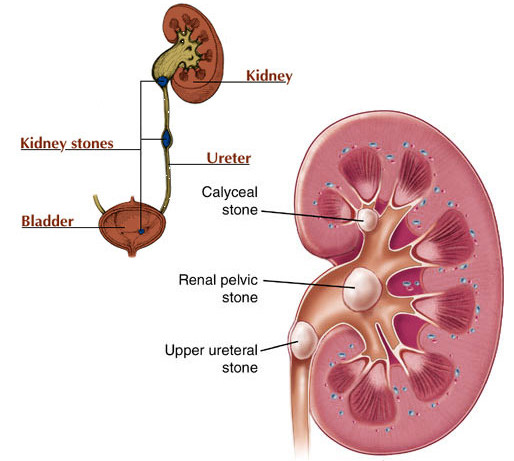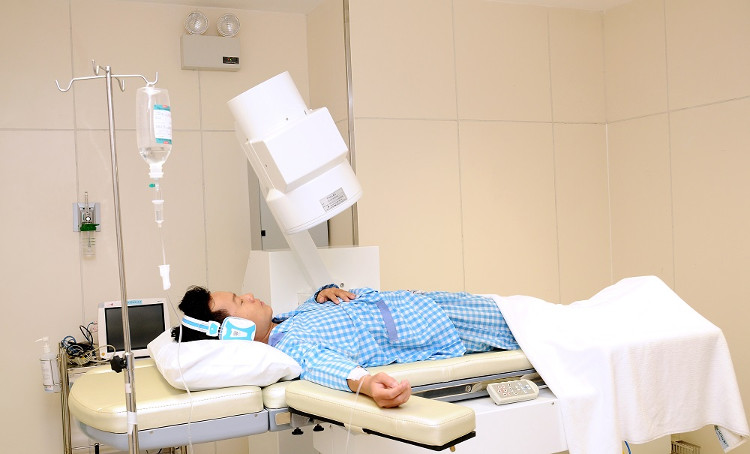Things to know about cutaneous kidney stones
is a process of accumulating long-term residues, which usually develop silently until there are clear signs on the body.
Kidney stones cause severe pain and affect body health as well as other organs in the body, and also affect the quality of life of patients.
Kidney stones can be completely prevented due to diet and exercise. However, due to the characteristics of the disease develop silently, when newly appearing, there are usually no obvious manifestations.

Kidney stones.
Currently, medical circles have a lot of methods to treat kidney stones, but kidney stones and kidney stones outside the body are considered the most advanced, modern and most effective solution today because the machine operates on the principle of Using shock waves outside the body, focusing on pebbles with a great pressure causes the stone to break and then follow the urine out.
So, how is the method of transdermal and extracellular renal lithotomy applied? What complications and complications can patients experience when they have kidney stones? Let's find out right away through the following article.
How can kidney stones be cut through the skin?

Percutaneous kidney lithotripsy is the most advanced modern solution available today.
Methods of treatment of percutaneous kidney stones, outside the body are performed if the size of the gravel is large, irregular in shape or is trapped in the ureter and cannot be passed while urinating. Kidney lithotripsy is a non-invasive procedure that uses shock waves to break up stones formed in the ureters, stones in the kidneys and bladder stones. There are many options for lithotripsy such as lithotripsy, transdermal gravel, lithotripsy .
Lithotripsy is performed if the gravel size is large, has irregular shapes or is trapped in the ureter and cannot be passed while urinating. The indication of lithotripsy is based on consideration of size, location, shape and amount of urinary organs. Before renal calculi, comprehensive examination and testing will be done to determine the number, location and size of stones.
Kidney lithotripsy through the skin, outside the body
You will be instructed not to eat or drink anything for at least 12 hours before gravel. Wear comfortable clothes so you can easily change into a surgical gown for surgery. The time of gravel can take about an hour. You get pain relief with tranquilizers to minimize pain and discomfort. There may be mild discomfort or pain during the procedure.
There are two techniques that are widely used in most health facilities. One is that you will lie on a soft mattress through which shock waves will pass. Using between 2000 and 8000 shock waves is necessary to destroy gravel.
The second method is that you will be asked to lie in a special bath filled with warm water, the gravel will be positioned by X-rays or ultrasound and the shock wave will be transferred directly from the caller gravel. is Lithotripter. Shock waves will pass through your skin and are completely harmless.

Before conducting kidney stones, the doctor will examine the film to assess the level of gravel.
Endoscopic kidney stones
The endoscope is used to get close to the stone inside the urinary tract and the laser wave is applied to break the gravel into small particles. Intracorporeal Shock Wave lithotripsy (ICSWL) or lithotripsy laser is usually performed when technical Extracorporeal Shock Wave (ECSWL) is not successful.
Gravel particles such as sand grains are captured in a basket (endoscopic device) and pulled out or beaded through natural urination. Sometimes stents are inserted into the ureter to protect the ureters and facilitate the passage of urine fragments and debris, over the next few days after the procedure.
Complications when kidney stones are outside the body
According to specialists, the incidence of complications, complications after low kidney stones, complications are usually mild and most can be treated internally for good results. Common complications and complications are pain after lithotripsy . There are many causes of complications when lithotripsy: lithotripsy, lithotripsy and professional level and experience of doctors performing this technique.
If the doctor is skilled, experienced and well-trained, when graveling, he will focus the laser beam on the target of the kidney stone and hit the target, carefully monitoring the patient while graveling to know the beam intensity is appropriate to adjust the increase, decrease accordingly and effectively.
Often patients have pain in the skin where the skin is exposed to the electrolysis machine and the organ pain (liver, kidneys, pancreas, and spleen) due to the tightening of the kidneys and organization around the kidneys. The patient may also have petechiae or skin bruises at the location of skin contact with the water bulb of the lithotripsy.
In addition, hematuria (more or less), damage to kidney damage after lithotripsy is also a common complication in most patients with lithotripsy.
Patients may also experience some less common complications such as hematoma under the kidney; the crushed gravel chain was stuck in the ureter because the broken stone escaped into the ureter much and quickly; Urinary tract infection progresses because the patient has a urinary infection that has not been actively treated before lithotripsy or because the bacteria have been released into the urine when the gravel breaks .
In particular, patients may also experience complications, rare complications such as rupture of the kidneys, rupture of the liver, splenic rupture; coughing up blood, pleural bleeding; pancreatitis causes an increase in Amylase in blood and urine; hepatitis causes an increase in SGOT, SGPT in the blood; Small intestinal hemorrhage, pain due to intestinal spasms.

Medical doctor prepared to spread kidney stones to a patient.
According to doctors specializing in percutaneous kidney stones, in addition to the body, the patient should be especially aware that if serious complications (rate of 0.5-1%) can be fatal for patients with severe urinary infections untreated to the grave. This will lead to sepsis or septic shock, which can cause death.
Particularly, complications of under- or out-of-shell renal failure (rate of 1-2%) are severe but can be preserved by conserving the kidney or may require removal of the kidney to stop bleeding.
- All you need to know about kidney stones
- The secret to kidney stones doesn't need surgery
- The new method allows two kidneys to be removed at the same time
- Having kidney stones should go to rollercoaster?
- Climate change increases kidney stones
- Nutrition to prevent kidney stones
- Calcium from milk does not increase the risk of kidney stones
- What to do to prevent kidney stones?
- Kidney stones are not frozen but continuously dissolve and develop
- 'Smart Stethoscope' helps assess the outcome of kidney stones
- Unpredictable complications of urinary stones
- Even drinking Vitamin C doubles the risk of kidney stones
 Green tea cleans teeth better than mouthwash?
Green tea cleans teeth better than mouthwash? Death kiss: This is why you should not let anyone kiss your baby's lips
Death kiss: This is why you should not let anyone kiss your baby's lips What is salmonellosis?
What is salmonellosis? Caution should be exercised when using aloe vera through eating and drinking
Caution should be exercised when using aloe vera through eating and drinking How to use vitamin C without harming the kidneys?
How to use vitamin C without harming the kidneys?  America transplanted pig kidneys to living humans for the first time
America transplanted pig kidneys to living humans for the first time  The first successful conversion of blood type in a human kidney
The first successful conversion of blood type in a human kidney  First successful pig kidney transplant for brain dead people
First successful pig kidney transplant for brain dead people  Who is susceptible to kidney disease? Is there any way to improve kidney health?
Who is susceptible to kidney disease? Is there any way to improve kidney health?  Beware of back pain
Beware of back pain 